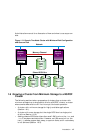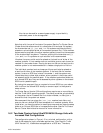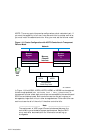
Note that in the configuration shown in Figure 1–6, there is only one shared
SCSI bus. Even by mirroring the clusterwide root and member boot disks,
the single shared SCSI bus is a single point of failure.
1.6.5 Creating a NSPOF Cluster
To create a no-single-point-of-failure (NSPOF) cluster:
• Use hardware RAID to mirror the clusterwide root (/), /usr, and /var
file systems, the member boot disks, quorum disk (if present), and data
disks
• Use at least two shared SCSI buses to access dual-redundant RAID
array controllers set up for multiple-bus failover mode (HSZ70, HSZ80,
and HSG80)
• Install a second Memory Channel interface for redundancy
• Install redundant power supplies
• Install redundant networks
• Connect the systems and storage to an uninterruptable power supply
(UPS)
Tru64 UNIX support for multipathing provides support for multiple-bus
failover.
______________________ Notes ______________________
Only the HSZ70, HSZ80, and HSG80 are capable of supporting
multiple-bus failover (SET MULTIBUS_FAILOVER COPY =
THIS_CONTROLLER).
Partitioned storagesets and partitioned single-disk units cannot
function in multiple-bus failover dual-redundant configurations
with the HSZ70 or HSZ80. You must delete any partitions before
configuring the controllers for multiple-bus failover.
Partitioned storagesets and partitioned single-disk units are
supported with the HSG80 and ACS V8.5.
Figure 1–7 shows a cluster configuration with dual-shared SCSI buses and a
storage array with dual-redundant HSZ70s. If there is a failure in one SCSI
bus, the member systems can access the disks over the other SCSI bus.
Introduction 1–15


















